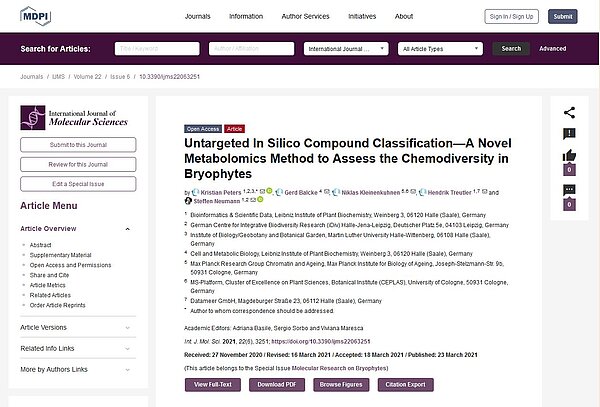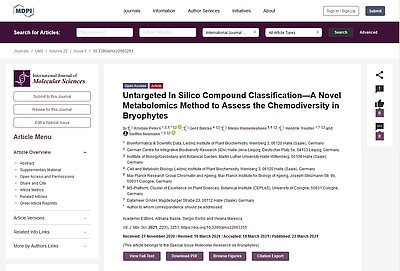Novel metabolomics method provides insights into ecology and chemodiversity.
In biodiversity research, plant samples are often collected at distant locations before being subjected to biochemical analysis months later in the home laboratory and usually in a dried state. Bioinformaticians at IPB, together with partners from MLU and iDiv, have now developed an in silico compound classification framework that allows the collection and pooling of all available theoretical fragment ion mass spectra for ecometabolomics analysis of whole plant groups. The framework program was established based on comparative metabolomics studies of ten different moss species, both freshly collected and in the dried state as herbarium samples. The bryophytes studied were first classified into different metabolite families based on biochemical-physiological processes. For example, metabolites that play a role in stability and structure (cell wall and membrane components, carbohydrates) or in chemical defense (polyphenols, steroids), in protection against reactive oxygen compounds (alkaloids, amino acids, flavonoids) or in plant nutrition and photosynthesis (nitrogen- and phosphate-containing glycerophospholipids) were recorded and assigned.
Using statistical test methods as well as various cluster and redundancy analyses, the Halle scientists observed qualitative and quantitative differences in the metabolite composition, which were closely related to the freshness of the samples and the species present in the postulated metabolite families. Based on the changes in metabolite spectra within the metabolite families, the bioinformaticians found clear evidence for ecological conditions, such as drought stress (by detection of proteins, flavonoids and terpenes), light availability, temperature and interactions with beneficial and harmful organisms. The compound classification based on physiological aspects proposed here allows a significant acceleration of complex annotation processes, according to the Halle scientists. It can be a powerful tool to identify relationships in both molecular biology by zooming in and ecology by zooming out. The framework developed allows the construction of new research hypotheses and their testing through detailed follow-up studies.



